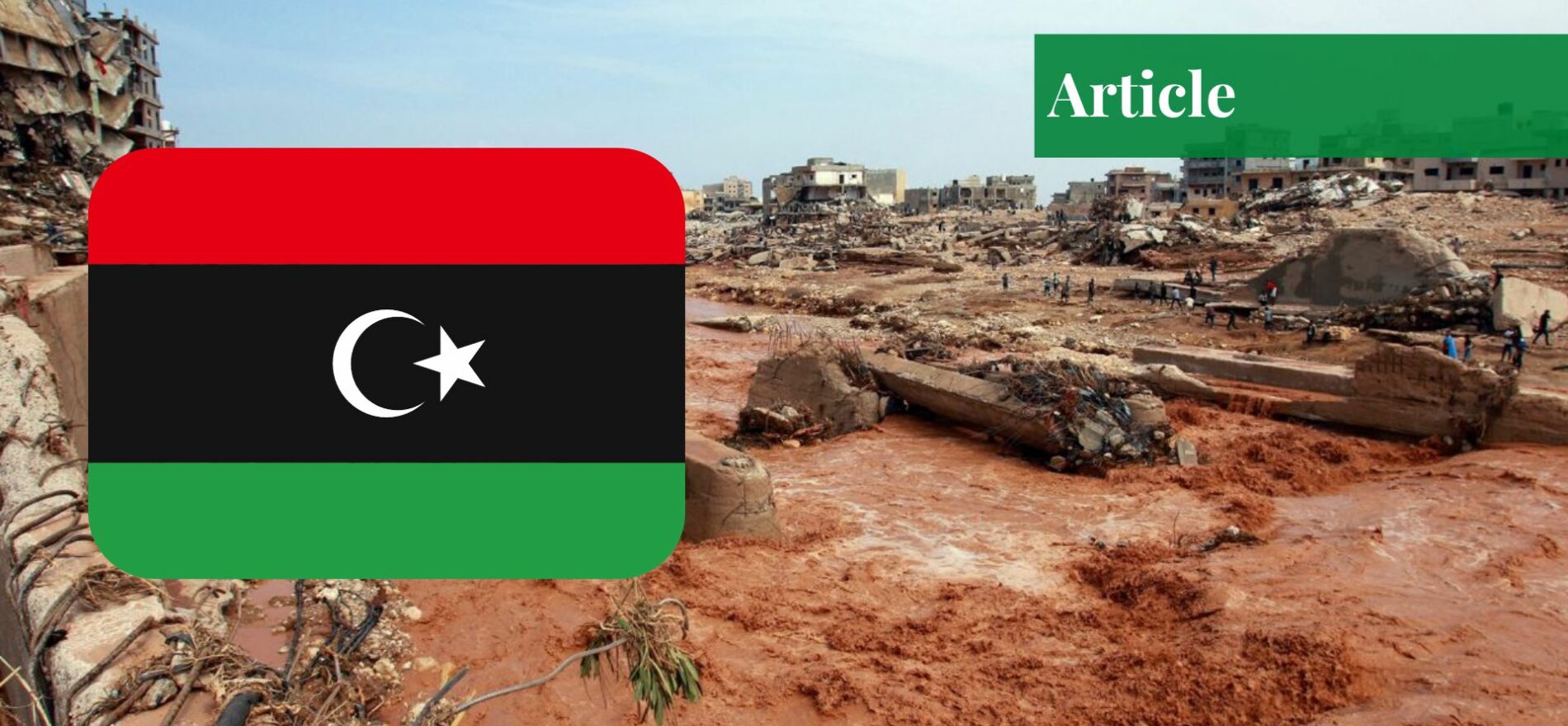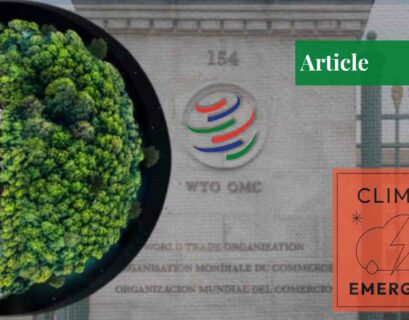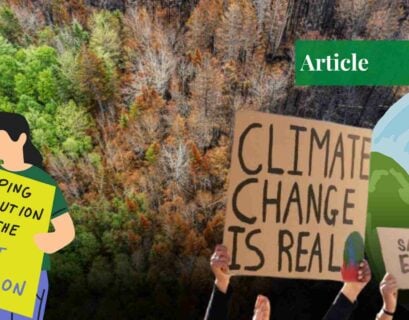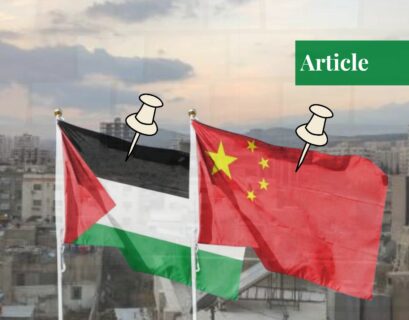Hafsa Ammar is a graduate of the National Defence University, Islamabad. Her areas of expertise are narrative building and propaganda warfare, centered around the Soviet Union and modern-day Russia.
Muslim states around the world are facing natural disasters and catastrophes, from earthquakes in Morocco to devastating floods in Libya. These states are already fragile, and further loss makes them even more vulnerable to internal and external threats.
2023 Libya Floods
September brought great tragedy for the North African state of Libya when Storm Daniel swept away its roads, fields, and infrastructure with eight months’ worth of torrential rain. What greatly aided in the destruction was the collapse of two dams, which allowed an additional billion cubic feet of water into the flow. The disaster first struck the small city of Derna on the 10th and 11th of September, a port city with a population nearing 100,000. Landsliding, the collapse of multi-story apartment towers, the destruction of crops, widespread loss of life, and damaged buildings were the initial issues. What followed was widespread panic, rioting, and food and water insecurity.
Dam Collapse
In September 2023, Libya faced a catastrophe of unparalleled proportions as it was ravaged by devastating floods. The effects of these floods were far-reaching, leaving behind a trail of destruction and human suffering. As the waters swept through cities and villages, homes were destroyed, infrastructure was decimated, and lives were upended.
In the aftermath of the floods, Hafsa Ammar sheds light on the extent of the damage caused and the challenges faced by the affected communities. From the loss of lives and displacement of people to the disruption of essential services like healthcare and clean water supply, the impact of these floods cannot be overstated.
Although Storm Daniel was aggressive enough on its own, much of the damage was due to the dam’s collapse. The deputy mayor reported that the dams were not maintained properly, and this neglect has been going on for around two decades now. They were not created with very large capacities; therefore, when one was flooded with rain, it crumbled, and the mere pressure of its released flow broke the next one.
A quarter of the city that was once boasted as the jewel of Libya has now been erased from the map. Initially, the World Health Organization (WHO) reported that over four thousand fatalities occurred, and even more had been left injured and homeless. However, the exact figure remains unknown owing to contesting statements from various sources. The United Nations Office for the Coordination of Humanitarian Affairs (OCHA) announced the death toll to be 11,300, with 10,100 people missing in Derna alone. Whereas, the mayor of Derna, Abdul-Moneim al-Ghaithi, predicted the number to reach twenty thousand. On the other hand, UNICEF reports that more than 16,000 have been displaced in eastern Libya.
Adverse Effects of the Floods in Libya
The first wave of damage includes destruction of life, property, roads, livestock, and other tangible belongings. The second wave is deemed to be a bigger threat, which encompasses all that follows. The aggrieved people were separated from their families and loved ones; homes were broken; the water became polluted; wounds and injuries caught infection without proper healthcare; there was frantic and vulnerable governance and deforestation, all as a result of the floods. Natural disasters such as floods interrupt power and gas lines, leaving people even more isolated. Waterborne diseases like cholera, typhoid, malaria, and dysentery spread like wildfire.
Recently, another threat came to light in the aftermath of the floods. Authorities reported that during and following the upheaval of Gaddafi, Libyan soil was made home to hundreds of land mines and other ordnance. An official from the offices of the Red Cross reported that there were stores of ammunition in Derna that were hit by the floods, and now they could be spread all over the place. State authorities have been using geoinformatics (GIS) technology to map out and get a general sense of where the ammunition could have ended up.
This is time-sensitive information because they need to warn the rescue personnel accordingly so they do not accidentally trigger a washed-up landmine when they go out to look for missing persons and dead bodies in the rubble. The worry is that unexploded mines or missiles become more sensitive to touch and handling once they have been moved into place. Humanitarian organizations are concerned about how to warn the public of this impending risk without causing a massive panic.
Their preferred method of approaching the issue is by posting warnings and alerts online. The International Committee of the Red Cross in Libya posted the following message in part on their social media page to warn the people:
“…The danger of explosive waste of war has increased throughout the city. And explosives from the war remain alive and dangerous. Citizens and rescuers need to be aware of this danger to minimize further loss of lives. If you find something, don’t try to move it. Mark the area to warn others and call the authorities!.”
Now that some time has passed, the civilians have reached the second stage of grief i.e., anger. They gathered to protest outside the Al Sahaba Mosque to demand accountability from the authorities. The protestors want more than simple monetary compensation; they want a full investigation to be carried out by the UN looking into the matter, down to Derna’s infrastructure budgets and allowances. The mayor was suspended instantly, but the rage was not quelled which led to the rioters setting fire to his home residence. The city council was sacked as well.
The state of Libya is in shambles in this heinous aftermath. Broken walls and cracked windows showcase not only the external damage but the internal destruction as well. Many have attributed the floods to the consequences of the exacerbated climate crisis; however, there are deeper politics at play here. The excessive rain wasn’t as much at fault as the neglectful municipality was when it overlooked the proper maintenance of the dams.
This is not mere speculation, as once the protests brought attention to this factor, journalists and media personnel were escorted out of the area, signaling secrecy over the matter. The weak governmental set-up has left the people and their grief to be used as a political tool. Two rival governments are fighting for power in Libya, one based in Tripoli and the other in Benghazi. Their lack of cooperation and continuous friction only aided in the massive death toll.
Conclusion
The international community rose to the challenge and sent aid. Qatar and Palestine sent medical and rescue teams, while the United States and the European Union mobilized funds for humanitarian assistance. Though more than a month has passed, Libya has a long road ahead of it for recovery.
If you want to submit your articles, research papers, and book reviews, please check the Submissions page.
The views and opinions expressed in this article/paper are the author’s own and do not necessarily reflect the editorial position of Paradigm Shift.


















